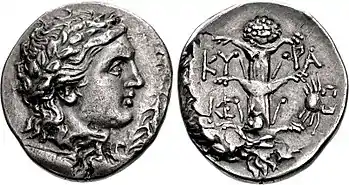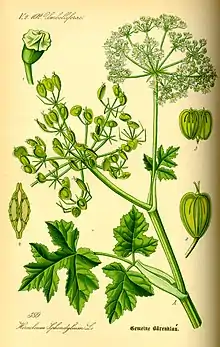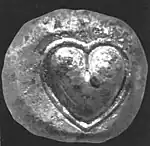Silphium
Silphium (also known as silphion, laserwort, or laser) is an unidentified plant that was used in classical antiquity as a seasoning, perfume, aphrodisiac, and medicine.[1][2]

It was also used as a contraceptive by ancient Greeks and Romans.[3] It was the essential item of trade from the ancient North African city of Cyrene, and was so critical to the Cyrenian economy that most of their coins bore a picture of the plant. The valuable product was the plant's resin (laser, laserpicium, or lasarpicium).
Silphium was an important species in classical antiquity, as evidenced by the Egyptians and Knossos Minoans developing a specific glyph to represent the silphium plant.[4][5] It was used widely by most ancient Mediterranean cultures; the Romans, who mentioned the plant in poems or songs, considered it "worth its weight in denarii" (silver coins), or even gold.[2] Legend said that it was a gift from the god Apollo.
The exact identity of silphium is unclear. It was claimed to have become extinct in Roman times.[6] It is commonly believed to be a fennel relative in the genus Ferula,[1] perhaps a variety of giant fennel. The extant plants Margotia gummifera,[7] Ferula tingitana,[8] and Ferula drudeana[9] have been suggested as other possibilities. Another theory is that it was simply a high quality variety of asafoetida, a common spice in the Roman Empire. The two spices were considered the same by many Romans including the geographer Strabo.[10] In 2021, a study from Istanbul University identified Ferula drudeana as a likely candidate for silphium, matching both the appearance of silphium in descriptions and the spice-like gum-resin of silphium, though without a surviving sample no genetic analysis can be made.[11][9]
Identity and extinction

The identity of silphium is highly debated. It is generally considered to belong to the genus Ferula, as an extinct or living species. The currently extant plants Margotia gummifera,[7] Ferula tingitana, Ferula narthex, Ferula drudeana, and Thapsia garganica have been suggested as possible identities.[1][9][8][12][13] Theophrastus mentioned silphium as having thick roots covered in black bark, about 48 centimeters long, or one cubit, with a hollow stalk, similar to fennel, and golden leaves, like celery.[2]

The cause of silphium's supposed extinction is not entirely known but numerous factors are suggested. Silphium had a remarkably narrow native range, about 125 by 35 miles (201 by 56 km), in the southern steppe of Cyrenaica (present-day eastern Libya).[14] Overgrazing combined with overharvesting have long been cited as the primary factors that led to its extinction.[6] However, recent research has challenged this notion, arguing instead that desertification in ancient Cyrenaica was the primary driver of silphium's decline.[15]
Another theory is that when Roman provincial governors took over power from Greek colonists, they over-farmed silphium and rendered the soil unable to yield the type that was said to be of such medicinal value. Theophrastus wrote in Enquiry into Plants that the type of Ferula specifically referred to as "silphium" was odd in that it could not be cultivated.[16] He reports inconsistencies in the information he received about this, however.[17] This could suggest the plant is similarly sensitive to soil chemistry as huckleberries which, when grown from seed, are devoid of fruit.[2]
Similar to the soil theory, another theory holds that the plant was a hybrid, which often results in very desired traits in the first generation, but second-generation can yield very unpredictable outcomes. This could have resulted in plants without fruits, when planted from seeds, instead of asexually reproducing through their roots.[2]
Pliny reported that the last known stalk of silphium found in Cyrenaica was given to Emperor Nero "as a curiosity".[6]
A 2021 paper made the case that Ferula drudeana, an endemic species found in Turkey, is the true identity of Silphium based on similarity of appearance and production of a resin with supposedly similar properties to Silphium.[18]
Ancient medicine
Many medical uses were ascribed to the plant.[19] It was said that it could be used to treat cough, sore throat, fever, indigestion, aches and pains, warts, and all kinds of maladies. Hippocrates wrote:[20]
When the gut protrudes and will not remain in its place, scrape the finest and most compact silphium into small pieces and apply as a cataplasm.
The plant may also have functioned as a contraceptive and abortifacient.[8][21] Many species in the parsley family have estrogenic properties, and some, such as wild carrot, are known to act as abortifacients.[21]
Culinary uses
Silphium was used in Graeco-Roman cooking, notably in recipes by Apicius.
Long after its claimed extinction, silphium continued to be mentioned in lists of aromatics copied one from another, until it makes perhaps its last appearance in the list of spices that the Carolingian cook should have at hand—Brevis pimentorum que in domo esse debeant ("A short list of condiments that should be in the home")—by a certain "Vinidarius", whose excerpts of Apicius[lower-alpha 1] survive in one 8th-century uncial manuscript. Vinidarius's dates may not be much earlier.[22]
Connection with the heart symbol


There has been some speculation about the connection between silphium and the traditional heart shape (♥).[23] Silver coins from Cyrene of the 6th–5th centuries BCE bear a similar design, sometimes accompanied by a silphium plant, and is understood to represent its seed or fruit.[24] Some plants in the family Apiaceae, such as Heracleum sphondylium, have heart-shaped indehiscent mericarps (a type of fruit).
Contemporary writings help tie silphium to sexuality and love. Silphium appears in Pausanias' Description of Greece in a story of the Dioscuri staying at a house belonging to Phormion, a Spartan, "For it so happened that his maiden daughter was living in it. By the next day this maiden and all her girlish apparel had disappeared, and in the room were found images of the Dioscuri, a table, and silphium upon it."[25] Silphium as laserpicium makes an appearance in a poem (Catullus 7) of Catullus to his lover Lesbia (though others have suggested that the reference here is instead to silphium's use as a treatment for mental illness, tying it to the "madness" of love[26][27]).
Heraldry
In the Italian military heraldry, Il silfio d'oro reciso di Cirenaica ("Silphium of Cyrenaica, smoothly cut and printed in gold; in blazon: silphium couped or of Cyrenaica") is the symbol granted to units that distinguished themselves in the Western Desert Campaign in North Africa during World War II.[28]
 Italian coat of arms Il silfio d'oro reciso di Cirenaica
Italian coat of arms Il silfio d'oro reciso di Cirenaica.svg.png.webp) Silphium depicted on the arms of Italian Libya
Silphium depicted on the arms of Italian Libya
See also
Notes
- A generic term for a cookery book, as "Webster" is of American dictionaries.
References
Footnotes
- Tatman, J.L. (October 2000). "Silphium, Silver and Strife: A History of Kyrenaika and Its Coinage". Celator. 14 (10): 6–24.
- Zaria Gorvett (2017). "The mystery of the lost Roman herb". BBC. Archived from the original on 2018-05-17. Retrieved 2018-08-27.
- Riddle, John M.; Estes, J. Worth (1992). "Oral Contraceptives in Ancient and Medieval Times". American Scientist. 80 (3): 226–233. Bibcode:1992AmSci..80..226R. JSTOR 29774642.
- Evans, Arthur (1921). The Palace of Minos : a Comparative Account of the Successive Stages of the Early Cretan Civilization as Illustrated by the Discoveries at Knossos. Cornell University Library. Macmillan and Co. p. 284.
{{cite book}}: CS1 maint: date and year (link) - Hogan, C. Michael (2007). "Knossos fieldnotes". Modern Antiquarian. Archived from the original on 11 July 2018. Retrieved 13 Feb 2009.
- Pliny, XIX, Ch.15 Archived 2022-09-28 at the Wayback Machine
- Amigues, Suzanne (2004). "Le silphium - État de la question" [Silphium - State of the art]. Journal des Savants (in French). 2 (1): 191–226. doi:10.3406/jds.2004.1685.
- Did the ancient Romans use a natural herb for birth control? Archived 2006-10-27 at the Wayback Machine, The Straight Dope, October 13, 2006
- Grescoe, Taras (23 September 2022). "This miracle plant was eaten into extinction 2,000 years ago—or was it?". National Geographic. Archived from the original on 25 September 2022. Retrieved 26 September 2022.
- Dalby 2000, p. 18.
- Miski, Mahmut (2021-01-06). "Next Chapter in the Legend of Silphion: Preliminary Morphological, Chemical, Biological and Pharmacological Evaluations, Initial Conservation Studies, and Reassessment of the Regional Extinction Event". Plants. 10 (1): 102. doi:10.3390/plants10010102. ISSN 2223-7747. PMC 7825337. PMID 33418989.
- Andrews, Alfred C. (1941). "The Silphium of the Ancients: A Lesson in Crop Control". Isis. 33 (2): 232–236. doi:10.1086/358541. JSTOR 330743. S2CID 144108503.
- Parejko, K (2003). "Pliny the Elder's Silphium: First Recorded Species Extinction". Conservation Biology. 17 (3): 925–927. doi:10.1046/j.1523-1739.2003.02067.x. S2CID 84007922.
- "Off this tract is the island of Platea, which the Cyrenaeans colonized. Here too, upon the mainland, are Port Menelaus, and Aziris, where the Cyrenaeans once lived. The Silphium begins to grow in this region, extending from the island of Platea on the one side to the mouth of the Syrtis on the other." (Herodotus, iv.168–198 on-line text Archived 2013-04-09 at the Wayback Machine)
- Pollaro, Paul; Robertson, Paul (2022). "Reassessing the Role of Anthropogenic Climate Change in the Extinction of Silphium". Frontiers in Conservation Science. 2. doi:10.3389/fcosc.2021.785962. ISSN 2673-611X.
- Theophrastus, III.2.1, VI.3.3
- Theophrastus, VI.3.5
- Miski, Mahmut (6 January 2021). "Next Chapter in the Legend of Silphion: Preliminary Morphological, Chemical, Biological and Pharmacological Evaluations, Initial Conservation Studies, and Reassessment of the Regional Extinction Event". Plants. 10 (1): 102. doi:10.3390/plants10010102. PMC 7825337. PMID 33418989.
- Pliny, XXII, Ch. 49 Archived 2007-12-28 at the Wayback Machine
- Hippocrates, Translated by Francis Adams. "On Fistulae, Section 9". Archived from the original on 2012-06-03. Retrieved 2012-03-25.
- Riddle, John M. (1992). Contraception and Abortion from the Ancient World to the Renaissance. Harvard University Press. p. 58. ISBN 978-0-674-16876-3. Archived from the original on 2021-09-03. Retrieved 2021-09-03.
- Maguelonne Toussaint-Samat, Anthea Bell, tr. The History of Food, revised ed. 2009, p. 434.
- Favorito, E. N.; Baty, K. (February 1995). "The Silphium Connection". Celator. 9 (2): 6–8.
- Buttrey, T. V. (1992). "The Coins and the Cult". Expedition. 34 (1–2): 59–66. Archived from the original on 2021-09-03. Retrieved 2021-09-03.
- Pausanias, 3.16.3 Archived 2021-02-25 at the Wayback Machine
- Moorhouse, A. C. (1963). "Two Adjectives in Catullus, 7". The American Journal of Philology. 84 (4): 417–418. doi:10.2307/293237. JSTOR 293237.
- Bertman, Stephen (December 1978). "Oral Imagery In Catullus 7". The Classical Quarterly. 28 (2): 477–478. doi:10.1017/S0009838800035060. S2CID 170172017.
- "Si distinsero i soldati del 28° Reggimento Fanteria "Pavia" il cui scudo reca nel terzo quarto una pianta di silfio d'oro reciso e sormontata da una stella d'argento"." (Gaetano Arena, Inter eximia naturae dona: il silfio cirenaico fra ellenismo e tarda antichità, 2008:13
Bibliography
- Dalby, Andrew (2000). Dangerous Tastes: The Story of Spices. University of California Press. ISBN 9780520227897.
- Herodotus. The Histories. II:161, 181, III:131, IV:150–65, 200–05.
- Pausanias. Description of Greece 3.16.1–3
- Pliny the Elder. Natural History. XIX:15 and XXII:100–06.
- Tatman, John. "Silphium: Ancient wonder drug?". Jencek's Ancient Coins & Antiquities. Archived from the original on 2007-03-30. Retrieved 2007-02-05.
- Theophrastus. Enquiry into plants and minor works on odours and weather signs, with an English translation by Sir Arthur Hort, bart (1916). Volume 1 (Books I–V) and Volume 2 (Books VI–IX) Volume 2 includes the index, which lists silphium (Greek σιλϕιον) on page 476, column 2, 2nd entry.
Further reading
- Buttrey, Theodore V; MacPhee, Ian (1998). The coins from the sanctuary of Demeter and Persephone. The University Museum. ISBN 978-0-924171-48-2. OCLC 611613435.
- Fisher, Nick (1996). "Laser-Quests Unnoticed Allusions to Contraception in a Poet and a Princeps?". Classics Ireland. 3: 73–96. doi:10.2307/25528292. JSTOR 25528292.
- Gemmill, Chalmers L. (1966). "Silphium". Bulletin of the History of Medicine. 40 (4): 295–313. JSTOR 44447186. PMID 5912906. ProQuest 1296321392.
- Helbig, Maciej (2012). "Physiology and Morphology of σίλφιον in Botanical Works of Theophrastus". Scripta Classica (9): 41–48.
- Koerper, Henry; Kolls, A. L (April 1999). "The silphium motif adorning ancient libyan coinage: Marketing a medicinal plant". Economic Botany. 53 (2): 133–143. doi:10.1007/BF02866492. S2CID 32144481.
- Riddle, John M. (1997). "Silphium". Eve's Herbs: A History of Contraception and Abortion in the West. Harvard University Press. pp. 44–46. ISBN 978-0-674-27026-8.
- Riddle, John M.; Estes, J. Worth; Russell, Josiah C. (1994). "Ever Since Eve... Birth Control in the Ancient World". Archaeology. 47 (2): 29–35. JSTOR 41770706. OCLC 5543506162.
- Tameanko, M. (April 1992). "The Silphium Plant: Wonder Drug of the Ancient World Depicted on Coins". Celator. 6 (4): 26–28.
- Tatman, J. L. (October 2000). "Silphium, Silver and Strife: A History of Kyrenaika and Its Coinage". Celator. 14 (10): 6–24.
- Wright, W. S. (February 2001). "Silphium Rediscovered". Celator. 15 (2): 23–24.
- William Turner, A New Herball (1551, 1562, 1568)
- Selivanova, Larisa (2018). "Растительный символ на монетах Кирены" [A Vegetation Symbol on Coins from Cyrene]. История (in Russian). 9 (2). doi:10.18254/S0002135-7-1.
- Asciutti, Valentina (2004). The Silphium plant: analysis of ancient sources (Thesis).
External links
- Contraception In Ancient Times: Use of Morning-After Pill by David W. Tschanz
- Silphion at Gernot Katzer's Spice Pages
- The Secret of the Heart
- Margotia gummifera
- Ferula tingitana